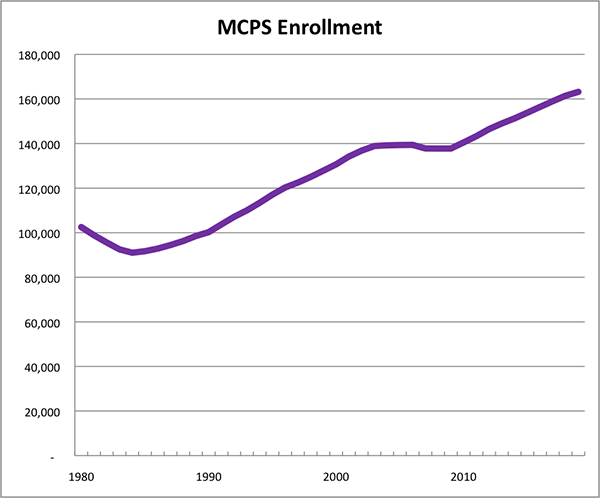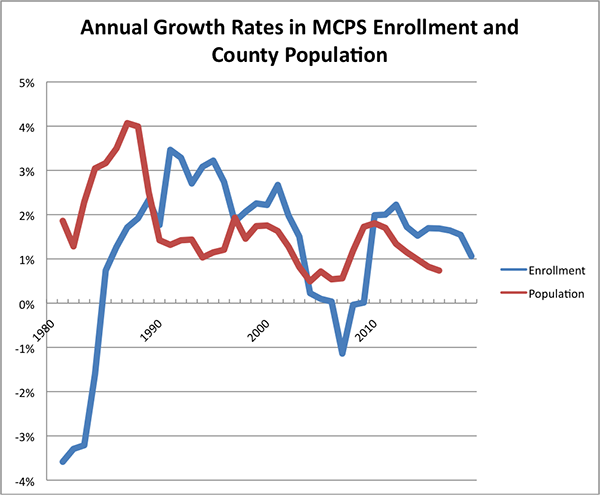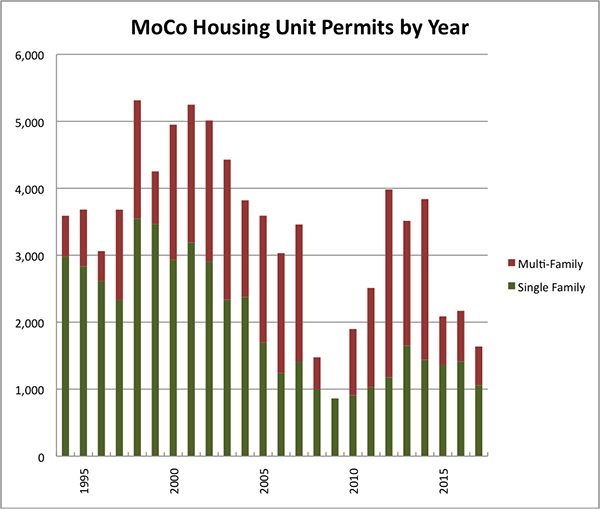New Development Has Not Caused School Overcrowding
By Adam Pagnucco.
One topic of debate during this election season is the relationship between school overcrowding and new development. There is no dispute that a majority of MoCo’s public schools are over capacity and the county is struggling to keep up with the system’s capital needs. The county’s population is growing and the council continuously approves new master plans that allow for a rising number of housing units to be built. So are these factors working together to crowd schools?
If new development was causing school overcrowding, we would expect to see simultaneous surges in MCPS enrollment, population growth and housing construction. But that’s not happening. In fact, the recent growth in school enrollment has coincided with anemic population growth and a drop in the housing market. Whatever is causing MCPS enrollment to rise, it’s not new development.
First, let’s look at long-term trends in MCPS enrollment. School enrollment has not grown in a straight line, but has had cycles. It fell in the early 1980s, rose through the early 2000s, was stable through 2009 and has been growing steadily since.

If raw population growth was fueling MCPS enrollment, we would expect to see a correlation between their annual rates of increase. In other words, periods of high enrollment growth would coincide with periods of high population growth. But in fact, the relationship between those two measures is not a tight one. In the 1990s, for example, population growth fell but MCPS enrollment rose. And between 2010 and 2016, enrollment grew by 1.8% per year while population grew by just 1.2% annually. Both measures are now trending down.

As for housing construction, it has been in decline since the Great Recession. The chart below shows the number of housing units permitted in MoCo annually from 1994 through 2017. From 1994 through 2007, the average number of housing units permitted in the county was 4,080 per year. Since then, the average number of units permitted has fallen to 2,398 per year. That drop in housing construction has coincided with the recent surge in MCPS enrollment, which began in 2010.

One more factor is worth mentioning: the nature of housing construction in Montgomery County has changed over the years. From 1994 through 2009, 37% of housing units permitted in the county were in multi-family structures. Since then, 54% of units permitted have been multi-family, and 95% of them were in structures of five units or more. That is relevant for school enrollment since the county Planning Department has calculated that high-rise units generate, on average, about a third of the students that single family units do. In other words, the kinds of units that are now being built in the county are associated with lower rates of school enrollment growth.
While school enrollment has risen in recent years, population growth has been low and housing construction has declined. New development has not caused school overcrowding. Demographic change and neighborhood turnover are much more likely factors in explaining enrollment growth. Moreover, attempts to stop development through moratoriums and measures like rent control are likely to backfire by depriving the county government of the revenue growth it needs to pay for more school construction. Shutting down development won’t alleviate school overcrowding, but it will lead to higher housing costs, economic stagnation and, eventually, more tax hikes.
Sources: County Executive’s recommended budgets for MCPS enrollment, U.S. Bureau of Economic Analysis for population and U.S. Census Bureau for building permits.